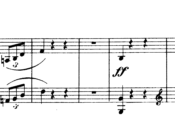Analysis
Contents
For the benefit of all pianists learning this work, we present to you a concise and easy to use analysis of Beethoven’s Piano Sonata No.25 in G major.
First Movement (Presto Alla Tedesca)
Form: Sonata Form. G Major.
EXPOSITION:
Bars 1-8: First Subject in G major (tonic). The first subject, consisting of a sentence of eight bars, begins and ends in the tonic key, and is constructed upon tonic pedal point.
Bars 8-24: Connecting Episode. The connecting episode begins with a modulation to the dominant, after some arpeggios in that key it modulates to A major. The end of it overlaps the entry of the second subject.
Bars 24-46: Second Subject in D major. The second subject commences with a four-bar phrase, Bars 24-27, repeated, Bars 28-31, the first two bars of which are in the key of A major. At Bars 32-33 the bass of Bars 28-29 is transferred from the bass to the treble. The subject ends with full close in the key of the tonic, Bars 45-46.
Bars 46-49: Bars 46-49 form a passage, leading, in the first instance, to the repetition of the exposition, and afterwards, with the addition of Bars 51-52 (omitting Bar 50), to the development.
Double bar and repeat.
DEVELOPMENT:
Bars 53-124: The development refers principally to the first subject and the episode. It commences with the former in the key of E major. The first part of the latter appears at Bar 100 in the key of E flat major.
RECAPITULATION:
Bars 124-131: First Subject in original key.
Bars 131-147: Connecting Episode. The connecting episode is of the same length, and is composed of the same material as the original one, but altered so as to end in D major.
Bars 147-169: Second Subject in G major (tonic).
Bars 169-174: Bars 169-174 form a passage, in the first instance, to the repetition of the development and recapitulation, afterwards, with Bars 175-176 (omitting Bars 171-174), leading to Coda.
Double bar and repeat from Bar 53.
Bars 177-End: Coda. The Coda is formed of reminiscences of the first subject, the first four bars of which are heard twice in the bass, repeated in the treble a note higher. The form of this movement closely resembles that of the last movement of No. 23, Op. 57.
Second Movement (Andante)
Form: Ternary Form. G Minor.
FIRST PART:
Bars 1-8: First Subject in G minor (tonic). The first movement consists of two sentences of four bars; the first ends in relative major key, the second ends in tonic key (G minor).
Bar 9: Bar 9 modulates to the key of E flat major.
SECOND PART:
Bars 10-17: Second Subject in E flat major. The second subject, which does not modulate, begins and ends in the key of E flat major.
Bars 17-22: Bars 17-22 form a passage leading back to the tonic key.
THIRD PART:
Bars 22-29: First Subject in original key.
Bars 30-End: Coda. The Coda is derived from the first subject.
Third Movement (Vivace)
Form: Rondo Form. G Major.
FIRST PART:
Bars 1-16: First Subject in G major (tonic). The first subject is divided into two parts; the first part, Bars 1-8, ending in dominant key; the second part. Bars 9-16, beginning in dominant and ending in tonic key. Both parts are repeated.
Bars 17-35: Episode. This episode consists of an eight bar sentence, Bars 17-25, in E minor, followed by several bars formed upon the first subject, modulating back to tonic key.
Bars 36-51: First Subject in original key. The first subject re-appears with a varied accompaniment; the repetition is omitted.
SECOND PART:
Bars 51-67: Episode in C major. This episode commences with a four-bar phrase, Bars 51-55, repeated a fourth higher, Bars 55-59. Bars 59-67 are a varied repetition of Bars 51-59.
Bars 68-73: Bars 68-73 form a passage leading to the third entry of the first subject.
THIRD PART:
Bars 73-96: First Subject in original key. The first part of the first subject, Bars 73-80 (which re-appears here with a new accompaniment), is repeated with considerable variation, Bars 81-88.
Bars 97-End: Coda. The Coda is entirely formed upon the first subject.









